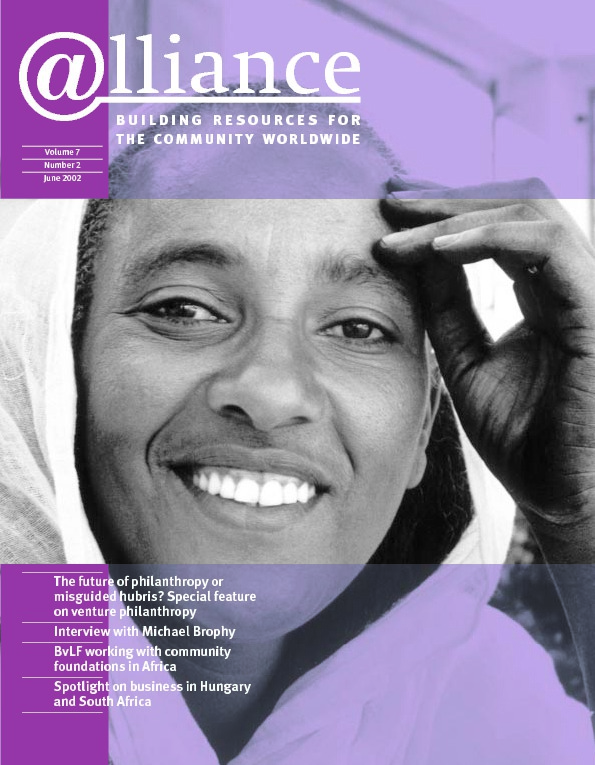Compartir FCI was the first community investment fund to be launched in Argentina. Though the attempt to constitute the fund was ultimately unsuccessful, the experience was nevertheless very rich. Although this model seems to fall more within the framework of socially responsible investment than venture philanthropy, the experience nevertheless demonstrates a real potential for venture philanthropy in Argentina.
The Compartir model[1] combines concepts from a typical endowment fund with those of traditional mutual funds. Compartir FCI invited institutional and individual investors to support a group of social projects during the life of the fund. Investors would recover their capital at the end of this period. The model works like an endowment fund in that it distributes only interest payments, with the important difference that investors can enter and exit the fund by buying or selling shares during this period.
Once we had identified a shortlist of projects to support, the investor subscription period began. The minimum capitalization needed to launch the fund was US$2 million, and we were able to gather commitments for around $1 million. As the subscription period progressed, it became evident that several factors were hindering our reaching our target.
Challenges to venture philanthropy in Argentina …
The highly unstable political and economic context tends to undermine long-term processes. The fund’s feasibility study was completed at approximately the same time that the Alianza government was elected in 1999, which theoretically at least provided a new four-year horizon, but from October 2000 (when the investor subscription period began) the country was engulfed in a political and later economic crisis. The Compartir focus on investing in government bonds, originally perceived as a conservative investment strategy, began to be seen as increasingly risky.
Higher levels of public recognition of the various institutions involved in creating the fund, and greater understanding and support from established organizations in the non-profit sector, would have provided greater credibility to our venture. Selecting some better known organizations to support as well as the community-based organizations we chose might also have helped us in terms of marketing the fund.
Argentines have a rather peculiar attitude towards innovation. Although innovative models generally attract great public interest, they also tend to arouse strong suspicion about the real motivation behind them. This is partly a response to many not very transparent practices in different sectors. A new model bridging the financial and non-profit worlds was almost bound to attract suspicion.[2]
… and the potential
On the other hand, several aspects indicate that venture philanthropy has potential in Argentina. Most people are more conscious than ever before of the degree of social inequality and poverty in the country. There is also a general consensus that NGOs need to decrease their dependence on donors. With lower levels of foreign funds and public funds becoming more scarce, it is crucial to create social enterprises which are independent and don’t rely exclusively on grants or subsidies.
What is absolutely clear, however, is that any new model would have to display high levels of transparency and accountability – tolerance of corrupt practices has run out. There is also a strong demand for serious attempts to measure the social impact of projects – all points which are fundamental in venture philanthropy.
There is also considerable interest on the part of investors, as evidenced by the actual investment commitments Compartir FCI did achieve and the hundreds of other meetings where we found support for the initiative. Additionally, VP models require much less capital to start operating than community investment funds such as Compartir FCI.[3]
What will be needed, however, is highly professional communication of what venture philanthropy is about, presenting it as complementing (not replacing) traditional grantmaking – and not as a panacea. Clearly, it is not a magical solution for all social problems, and no false expectations should be created in a society that is tired of them. Our experience at Compartir FCI can probably be seen as an extensive feasibility study, from which a new business plan will have to be built when the context is right.
1 A closed-end fund, constituted with a specific amount of capital and lasting for a predetermined period, with a shared-return mechanism.
2 The Argentine non-profit sector in particular has suffered from dubious cases related to tax evasion and organizations seeming to be created simply to receive public gifts – to the point where the word ‘foundation’ automatically has dubious connotations.
3 In community investment funds only interest earnings are distributed, so you need a substantial capital base to generate enough interest to distribute.
Juan Pablo Iribarne was a co-founder of Compartir FCI. He is now Enterprise Development Associate at NESsT. He can be contacted at jpi@rdc.cl





Comments (0)